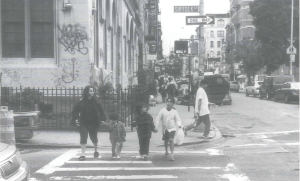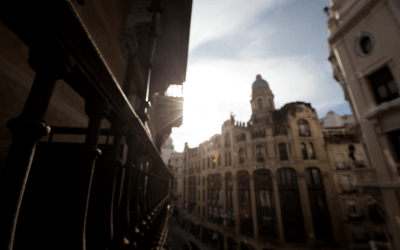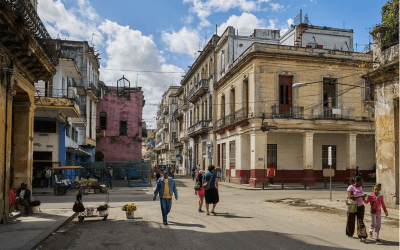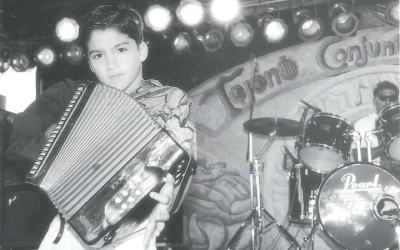Nueva York, Diaspora City
Latin@s Between and Beyond

Crossing Suffolk Street. Photo by Miguel Trelles.
New York magazine has been renamed Nueva York, at least for a week. The Spanish word on the cover of the 6 September 1999 issue is an eye-catcher for readers of the popular weekly, and attests to the currency of things, and words, “Latin” among the contemporary public in the United States. Before you know it, all New Yorkers, and all America, will be “living la vida loca” on the streets of Nueva York!
As the millennium approaches, Latin@ fever is gripping U.S. popular culture at a pitch unprecedented in the protracted history of that continental seduction. Hardly a week passes without still another media special, and hardly an area of entertainment and public life–sports, music, movies and television, advertising, fashion, food–is by now untouched by an emphatic Hispanic presence. Visibility is of course not new to the “Latin look” in American pop culture–think of Carmen Miranda, Ricardo Montalbán, or Desi Arnaz–nor is the Latin “flavor,” the salsa y sabor, a new ingredient in the proverbial melting pot, be it musical, sexual, or culinary. But those passing crazes and that subliminal sense of otherness have become in the present generation a veritable saturation of the pop public sphere, the “Latin” way attaining to a ubiquity and prominence that has converted it into an active shaper of contemporary tastes and trends.
Underlying this spectacular cultural ascendancy are major demographic and economic changes, resulting in the incremental growth and enormous diversification of the Latin@ population in the U.S. The swelling influx of Dominicans, Mexicans, Colombians, Ecuadorians and numerous other Latin American nationalities has meant that “Latin New York,” for decades synonymous with Puerto Rican, has become pan-ethnic. Puerto Ricans, while still the most numerous group, now comprise less that half the aggregate. By 1999, then, it was high time that New York become Nueva York, and that its burgeoning population of Spanish-language background be given its day in the glitz.
Visibility, though, can do as much to obscure as to illuminate, particularly when it remains so preponderantly concentrated in the image-making of the commercial culture. In the case of U.S. Latin@s, celebrity status and ceremonial fanfare is clearly one of those mirages, serving effectively to camouflage the structured inequality and domination which accounts for their diasporic reality in the first place, and deflecting public attention from the decidedly unceremonious and unenviable social status of the majority of Latin@ peoples. The spectacular success stories of the few serve only to mask the ongoing reality of racism, economic misery, and political disenfranchisement endured by most Latin@s, who moved northward from their homelands only because of persistent inequalities at global and regional levels.
But the Latin@ avalanche has given birth to the “sleeping giant,” a demographic and cultural monster whose immense commercial and electoral potential has only begun to be tapped and who, if roused, could well upset some of the delicate balances necessary to the prolongation of the “American Century.” Typically, awe and fascination mingle with a sense of foreboding, an alarmism over the imminent threat Latin@s are perceived to present to the presumed unity of American culture, and to an unhampered control over the country’s destiny. An integral component of this nervous prognosis, repeated with mantra-like predictability when public discussion turns to the “browning of America,” is the identification of Latin@s as the country’s “fastest growing minority,” the group whose numbers are on pace to exceed that of African Americans as early as the first decade of the new millennium. The fear of an “alien nation”–the title of a recent xenophobic book on immigration–veils but thinly an even deeper phobia, the fear of a non-white majority.
Such calculations, however, beg more questions that they answer when it comes to assessing the cultural and political relations which prevail in contemporary society. Most obviously, they take for granted the sociological equivalence of the various “minority” groups, in this case Latin@s and African Americans, as though a diverse set of immigrant and colonially conquered populations occupy the same historical position, and constitute the same kind of collective association, as a group unified, within the United States, on the basis of their common African ancestry and history of enslavement. Of course African Americans like all other groups have long differed along class, gender, color, regional and other lines, but the seams in the Latin@ patchwork stand out as soon as we go beyond the media hype and wishful census counts and undertake comparative analysis of any rigor. Even the obvious commonalities like language and religion, for example, turn out to be deceptive at best in light of the millions of Latin@s who are neither Spanish-speaking nor of the Catholic faith.
But beyond that, it is certainly a spurious sociological exercise to conjoin in one unit of discourse Puerto Ricans and Mexican Americans on the one hand, whose position in U.S. society is fully conditioned by legacies of conquest and colonization, with on the other hand immigrant and exile nationalities of relatively recent arrival from varied national homelands in Latin America. Differences along the lines of economic class and educational and entrepreneurial capital are striking, as are those having to do with issues of race and national cultures.
At least one of the spokesmen cited in Nueva York voices a sensitivity to the pitfalls of this pan-ethnic labeling process. The Dominican writer Junot Díaz is skeptical about any and all ethnic generalizations, stating about “Latin@s” that “I’d rather have us start out as fractured so we don’t commit the bullshit and erasures that trying to live under the banner of sameness entails.”
What is not mentioned in the pages of Nueva York, by Junot Díaz or any other commentator, is the most consequential of the “erasures” involved in pan-ethnic naming–the relation of Latin@s to blackness, and to African Americans in particular. While the Latin@ concept does generally indicate otherness, “people of color” and non-white, the history of social categorization has selectively equivocated on the issue, and many media representations allow for, or foster, a sense of compatibility with whiteness; the Latin@ faces shown for broad public consumption, whether it is Daisy Fuentes, Keith Hernandez or Chita Rivera, tend to be decidedly from the lighter end of the spectrum. The unspoken agenda of the new Latin@ visibility, and of the imminent surpassing of African American as the largest minority, is the ascendancy of a non-black minority. To mollify the fears of an invasion from south of the border is the consolation that at least their presence does not involve dealing with more souls of more black folk.
Yet social experience tells us otherwise. The rampant “racial profiling” and waves of police brutality are directed against both African American and Latin@ victims, with no color distinctions of this kind playing a role. For the fact is that, in many inner-city situations, there is no such difference, and it is not possible to “tell them apart.” What the hegemonic, consumer version of Latin@ ethnicity obscures is that many Latin@s are black, especially according to the codes operative in the United States. And what is more, while this version tends to racialize Latin@s toward whiteness, much in tune with the racist baggage of Latin American and Caribbean home cultures, on the streets and in the dominant social institutions “brown” is close enough to black to be suspect.
In Nueva York in particular, where the prevalent Latin@ presence and sensibility remains Caribbean, this counter-position to blackness is often disconcerting at best, and among many Puerto Rican and Dominican youth the response has been to reaffirm a sense of belonging to an African diaspora. Indeed, in the case of Puerto Ricans this perspective entails not only an emphasis on Afro-Boricua heritages but, because of the decades-long experience of close interaction with African Americans in New York, an identification and solidarity with American Blacks perhaps unmatched by any other group in the history of the “nation of immigrants.” Cultural expression in all areas–from language and music to literature and the visual arts–typically illustrate fusions and crossovers, mutual fascinations and emulations, that have resulted in much of what we identify, for example in the field of popular music, as jazz, rock and roll, and hip-hop. Collectively, and as a reflex of broader social experiences, this demographic reality and this conjoined cultural history put the lie to any wedge driven between Latin@ and black life and representation.
For example, the spoken word artist “Mariposa” (María Fernández) objects to being called a “Latina writer,” as present-day literary marketing would group her, reminding her audience that “I myself feel more in common with my sistahs [African American women writers] than with, say, Chicana poets like Sandra Cisneros or Lorna Dee Cervantes.”
Yet Mariposa does not consider this intense affiliation with African Americans to stand in any conflict with her Puerto Rican background. On the contrary, in her signature poem, “Ode to the DiaspoRican,” she signals her “pelo vivo” and her “manos trigueñas” as evidence of her national identity, and rails against those who would deny it:
- Some people say that I am not the real thing
- Boricua, that is
- cuz I wasn’t born on the enchanted island
- cuz I was born on the mainland….
- cuz my playground was a concrete jungle
- cuz my Río Grande de Loiza was the Bronx River
- cuz my Fajardo was City Island
- my Luquillo, Orchard Beach
- and summer nights were filled with city noises instead of coquís
- and Puerto Rico was just some paradise that we only saw in pictures
- What does it mean to live in between…..?
Mariposa thus gives voice to the sentiments of many young Puerto Ricans, and of many Latin@s in general, in their defiance of a territorially and socially confined understanding of cultural belonging. Place of birth and immediate lived experience are not wholly definitive of cultural identification, which in this view has more to do with political and social experience, and with personally chosen ascription. “No nací en Puerto Rico,” she exclaims in the poem’s refrain, “Puerto Rico nacío en mi.”
As these instances show, present-day social identities press simultaneously in varied directions, linking individuals and groups along lines that would appear mutually exclusive according to their representation in commercially and ideologically oriented media. Nueva York, New York magazine’s momentary interlude as a Latin@-focused publication, dwarfs the cultural horizons of Latin@ experience by postulating its categorical differentiation from blackness, and also by disengaging Latin@ culture in the U.S. from its moorings in Latin American and Caribbean realities. Not only are the featured Latin@ celebrities treated as interchangeable in their collective background, but in the entire issue no mention is made of Mexico, Puerto Rico, Cuba, the Dominican Republic, or Colombia except as potential extensions of the U.S. market. What is more, there is no discussion of the massive migrations from those home countries, nor of the historical relations with the U.S. which have generated modern migratory movements, as the transnational origin and setting for the very presence and position of Latin@s in U.S. society.
Today’s global conditions impel us beyond these tidy, nationally constricted views of cultural identity, which might well be referred to as “consumer ethnicities.” The Latin@ community is if anything a process rather than a circumscribed social entity, and its formation entails complex and often converging interactions with other, purportedly “non-Latin@” groups such as African Americans and American Indians. But the idea of the pan-Latin@ necessarily implies the trans-Latin@, the engagement of U.S.-based Latin@s in the composition of cultural and political diasporas of regional and global proportions. The interdependence of old and new “homes,” the constant bearing of U.S. policies and practices on the life circumstances in Latin America and the Caribbean, propel more and more Latin@s across the hemispheric divide, and resonate loudly in the everyday lives of all Latin@s. But beyond those direct geopolitical ties, awakened cultural heritages and congruencies also engage Latin@s in more abstract but no less pronounced diasporic affiliations, notably transnational indigenous and “Black Atlantic” trajectories of identity formation.
The “new Nueva York” is rich with these innovative cultural possibilities, and as the newfound home of so many people from so many Latin American countries it now serves as a seminal ground for the re-thinking and re-imagining of America. One hundred years after the prophetic ruminations of José Martí about the contours of “nuestra América,” we are now in a position to conceptualize “América” itself in its world context, and the multiple lines of an “American” identity as coordinates of radical transnational remappings. The “Latin explosion” receiving so much coverage in the U.S. today, the hyperboles and hypes generated by “la vida loca,” is but one index of a pervasive change in human affairs, leaving all of us asking, with Mariposa, “what does it mean to live in between?”
Juan Flores is a professor at Hunter College and the CUNY Graduate Center. His books include Divided Borders: Essays on Puerto Rican Identity, La Venganza de Cortijo y otros ensayos, and From Bomba to Hip-Hop: Puerto Rican Culture and Latino Identity (Columbia University Press, 2000). During the Spring 2000 semester he is teaching a course, “Islands and Enclaves: Caribbean Latino Literature in the U.S.” in the Spanish Department at Harvard.
Related Articles
Forum on U.S. Hispanics in Madrid
The Trans-Atlantic Project, an academic initiative to study the cultural interactions between Europe, the U.S. and Latin America has been invited by Casa de América, Madrid, to present a …
Cuba Study Tour
Waiting at José Marti International Airport for the first Harvard students to arrive for January’s DRCLAS Cuba Study Tour, my companion, a theater critic at Casa de las Américas, commented to me …
The Soulfulness of Black and Brown Folk
And so, by faithful chance, the negro folksong – the rhythmic cry of the slave – stands to-day not simply as the sole American music, but as the most beautiful expression of human experience …




